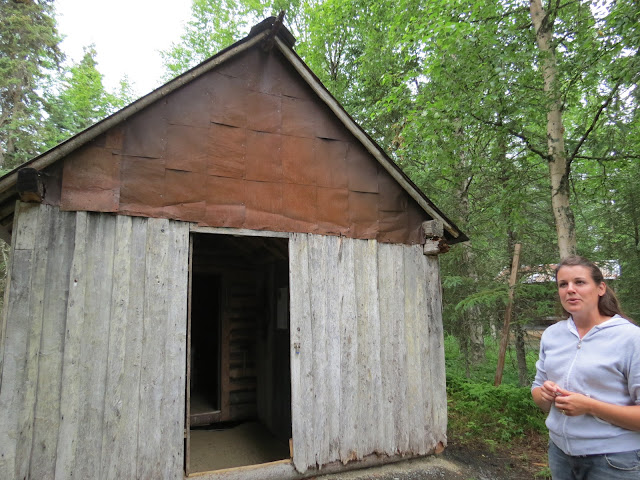It was all about salmon fishing at the mouth of the Kenai River. A tent city forms along the banks, and all those dots in the water are fishermen with big round dip nets.
They stand in the cold water holding that net and wait for salmon to swim into it. Dip-net fishing is open to Alaska residents exclusively.
It gets really crowded on the point.
Tina forgot her camera, so I took her picture to prove she was there.
This was really a small crowd as it was not yet the right tide.
This is a bad year for King Salmon as the numbers have been low, so King salmon fishing has been closed to protect next year's salmon. Any Kings caught accidentally while fishing for other salmon must be released. In town, protesters were marching with signs because Set-netting has also been closed. I wasn't familiar with Set Netters, but found some information about it. Fishermen in boats use gill nets to catch the salmon. A lot of salmon fishing boats are not going out because it's not profitable with the price of gas. Other types of salmon sell for less than $1 a pound, while King salmon sell for $5/pound.
Alaskans who rely on their King salmon catch are worried about not being able to fill the freezer for the winter months.
While in Kenai we did a walking tour of the old Russian town. In the background is the 1906 Chapel of St. Nicholas, built as a tribute to Igumen Nikolai, the first missionary in the Kenai area. Nikolai was responsible for bringing smallpox vaccine to the Kenai Peninsula and vaccinating many people in the fight against this deadly disease.
The 1918 Oskoldof/Dolchok house remains in its original location and is a good representative of what buildings in early Kenai looked like. It is one of 3 homes currently in Old Town that were built by a Kenaitze Indian.
Constructed in 1894, this Russian Orthodox Church is one of the oldest standing Orthodox churches in Alaska. Church services are still regularly held.
Built in 1881, the Parish House Rectory is the oldest building on the Kenai Peninsula and has continued to be used as a residence since that time.
The Interlocked Moose Horn Club Tomrdle House (now a private residence) was completed in 1902.
Its history...
Several early trapper's cabins have been relocated here.
We left Kenai and drove south on the Kalifornsky Beach Road. When we arrived at the small town of Kasilof we stopped at this museum where I learned who and what Kalifornsky was.
All that remains of Kalifornsky Village is a small cemetery. The last inhabitant, Peter Kalifornsky, died in 1993 and is buried there with his ancestors. The village itself was established in 1821 by Qadanachan Kalifornsky (meaning "the Californian). He had gone to California with the Russians and was so named on his return.
A couple of plaques outside the museum:
In addition to the Salmon Cannery, Silver fox farming was an important industry in Kasilof. Many buildings of the early community are being preserved and restored by volunteers. Work is done on the restorations mainly in the winter months.
This is the kitchen of Abe Erikson's fox-farm cabin. It was a bachelor's cabin.
Note the modern portable bathtub.
Which came from Sears & Roebuck.
This lovely young lady grew up here and was a wonderful guide. Too bad I can't remember all she told us. I do remember that the roof and gable of this trapper cabin was made with salmon cans. The owner, Victor Holm was a Finnish immigrant who came to Alaska as an employee of the Salmon Cannery. Most such immigrants left after the summer salmon season, but not Victor. Around 1890 he built a cabin along the Kasilof River near the cannery and became the first non-native resident of Kasilof. In the winter he trapped fur-bearing animals. He built this cabin to stay in along his trap route.
Inside the cabin. Trappers who used the cabin often recorded their visit on the wall above the window.
Tina studies the construction.
You can just make out the writing on the wall.
"April 7, 1917 Came across country from Hugos AB." AB was Andrew Berg.
Restorer's of the Watchman's Cabin are preserving the log dated 1891.
Salmon can crates were dismantled to use on the ceiling.
Logs were chinked with moss.
Our guide noted that the joints made for this house were unusual and showed a different building style, perhaps Bulgarian, was used.
These wedge-shaped joints were typical of most cabins.
The picture below shows the "Slackwater Cabin," another trapper's cabin.
It was built of lumber from dismantled fish traps.
It was chinked with strips of canvas cloth.
And rope.
This building was the fox farm kitchen, where food was prepared to feed the foxes. Fox pens were outside.
The cupola was used for watching the fox without disturbing them.
THe inside of the fox pens had two rooms.
Foxes entered through the little tunnel. After Silver fox fur fell out of fashion, the fox farms went out of business.
Hope you enjoyed your tour of historic Kasilof (which is pronounced Ka-see'-lof)







































Bet those cabins made from fish crates smelled for quite a while. Such an interesting tour and great pictures.
ReplyDelete